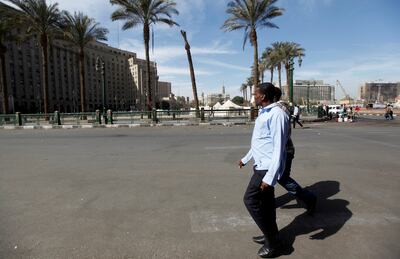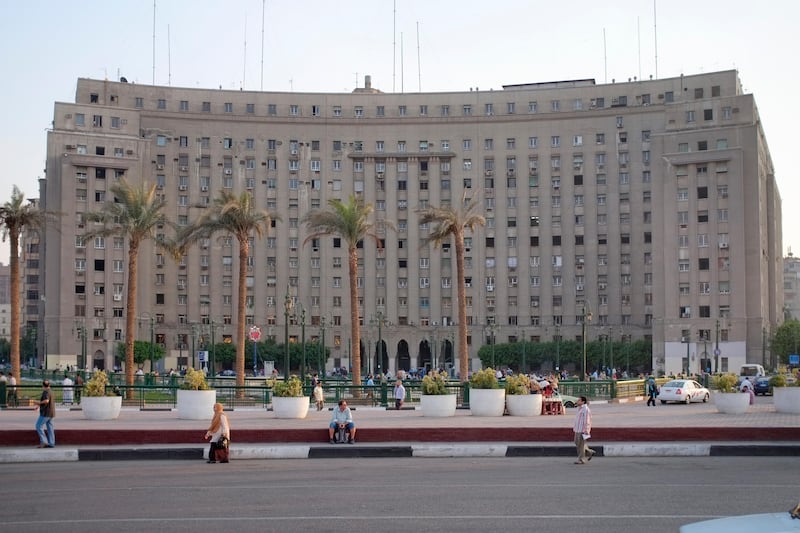The gargantuan state-owned building known as Mogamaa El Tahrir in downtown Cairo has been a symbol of Egypt's cumbersome bureaucracy since it was built in the early 1950s.
The complex has a strong reputation as a labyrinth where patience is tested as thousands of people move from one of the hundreds of offices to another in pursuit of official documents and rubberstamp approvals.
But that is all set to change after an announcement this week that the Sovereign Fund of Egypt and the Ministry of Planning signed a 3.5 billion Egyptian pound ($222.7 million) contract with a consortium of three international companies to renovate the Mogamaa and convert it into a site that will include a hotel, apartments, offices, retail spaces and restaurants.
“The Mogamaa begins a new journey from an old and distinctive government building in the heart of Cairo to a distinguished multipurpose complex that will attract international tourism and major international and regional companies,” said Ayman Soliman, chief executive of the Sovereign Fund of Egypt.
The consortium comprises the UAE’s Al Otaiba Investments; the Oxford Capital Group, a property investment, development and management company in the US; and Global Ventures Group, an American organisation that promotes business development opportunities in the Mena region.
Hala El Said, Egypt's minister of planning and economic development and sovereign fund chairwoman, said the selection reflects the body's strategy of developing the country’s assets and attracting investment to maximise their value.
While only 70 years old, the Mogamaa has a strong history in Egyptian society, both in cultural and political contexts.
The complex featured prominently in the 1992 film El Erhab Wa El Kebab (Terrorism and Kebab), a comedy in which an Egyptian man becomes so frustrated by bureaucratic inefficiency that he takes everyone in the building hostage.
Opposite the building is Tahrir Square, where protests in 2011 and 2013 temporarily shut down the Mogamaa.
“In many different ways, almost every single Cairene has had some sort of relationship with this building,” said Yasmine El Dorghamy, founder of Rawi, a bilingual magazine about Egypt’s history and heritage.
It now sits abandoned, with the exception of security agents, police officers, street vendors and passing pedestrians outside the building. The decaying 14-storey structure, with its broken windows and peeling paint, has been empty for months.

Developer Oxford Capital Group’s previous projects include the transformation of Chicago’s 1923 London Guarantee building into the luxury lifestyle hotel London House.
“London House in downtown Chicago reminds us a lot of Mogamaa,” John Rutledge, founder and chief executive of the group, said in a promotional video for the new project.
The London Guarantee building “was beautifully located, it was beautiful architecture, but it was dilapidated and falling apart”, he said.
“So we acquired it and executed a comprehensive redevelopment … and it’s now the No 1 rated hotel in Chicago and one of the top hotels in the country,” he said.
The plan is to rebuild the Mogamaa as an “elegant destination” that will become “an anchor and catalyst for revitalising the whole area”.
The project is expected to take about two years to complete once development work begins, Ms Said said.
The Mogamaa was designed by Egyptian architect Mohamed Kamal Ismail, who died in 2008. His most prominent works include the High Court of Egypt and the expansion of the Grand Mosque of Makkah and the Prophet’s Mosque in Madinah.
It was inaugurated in 1952 under King Farouk, before a military coup in Egypt overthrew the monarchy in July that year.
“This is not a Soviet building, like a lot of people think it is,” Ms Dorghamy said. “It was built to house thousands of government employees. [The architect] built it with a functional approach.”
She has “mixed feelings” about the plans for renovation, saying the building has “a lot of potential to be beautiful” but has been “viewed in an unfair light” owing to the unpleasant experiences of many people who went there to have paperwork done.

Omar Samir, 33, walks past the Mogamaa at least four days a week on his way to work as an anesthesiologist.
“I hope it doesn’t get destroyed. They should renovate the building, but still preserve its old look,” he said.
But Abdel Wahab Abdel Ghani, 65, who has been working as a cleaner in the area for the past 20 years, said the building was in dire need of a revamp.
“They only put a coat of new paint on it a few years ago. It can’t stay like this,” he said.
In 2019, the government started to move employees out of the Mogamaa to various locations, including a new passport and visa headquarters in the Abbasiya district of Old Cairo.
“It used to be that this was the only place you could do bureaucratic work. Now it’s spread out, based on where you live,” said Ahmed Ali, a 30-year-old office administrator.
Tens of thousands of civil servants, as well as government ministries, will soon be relocated to the New Administrative Capital, about 45 kilometres east of Cairo. The large-scale project has been under construction since 2015.
A rehabilitation project in central Cairo has been continuing since 2008 through Al Ismaelia for Real Estate Investment. The company seeks to preserve the gems of the 19th-century district built by Khedive Ismail, while upgrading and improving the use of the spaces.
The company has restored famous buildings such as La Viennoise and Cinema Radio, and introduced modern concepts such as the Consoleya co-working space.
“Everybody sees that downtown is heading somewhere … the government did a great job of renovating Tahrir Square and eventually they’re now doing different parts of the area,” chairman Karim Shafei told The National.
“With that happening, people are getting super excited about downtown.”







